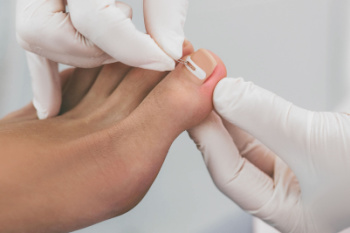
Ingrown toenails occur when the edges of a toenail grow into the surrounding skin, leading to pain, redness, and swelling. Common causes include improper nail trimming, tight footwear, and foot injuries. Symptoms include throbbing pain and discomfort, especially when wearing shoes. Treatment typically begins with conservative measures like soaking the foot and using roomy shoes. However, for persistent cases, the Winograd procedure may be necessary. This surgical method involves removing the ingrown portion of the nail and the underlying tissue to prevent the nail from growing back incorrectly. The procedure is usually performed under local anesthesia, minimizing discomfort and ensuring a quick recovery. A podiatrist specializes in diagnosing and treating ingrown toenails, providing personalized care and expert guidance. If you are experiencing symptoms, it is suggested that you make an appointment with a podiatrist. They can offer effective treatments, including the Winograd procedure, to relieve your pain and restore your foot health.
Ingrown toenails may initially present themselves as a minor discomfort, but they may progress into an infection in the skin without proper treatment. For more information about ingrown toenails, contact Dr. Howard Horowitz of Bowie Foot & Ankle . Our doctor can provide the care you need to keep you pain-free and on your feet.
Ingrown Toenails
Ingrown toenails are caused when the corner or side of a toenail grows into the soft flesh surrounding it. They often result in redness, swelling, pain, and in some cases, infection. This condition typically affects the big toe and may recur if it is not treated properly.
Causes
- Improper toenail trimming
- Genetics
- Improper shoe fitting
- Injury from pedicures or nail picking
- Abnormal gait
- Poor hygiene
You are more likely to develop an ingrown toenail if you are obese, have diabetes, arthritis, or have any fungal infection in your nails. Additionally, people who have foot or toe deformities are at a higher risk of developing an ingrown toenail.
Symptoms
Some symptoms of ingrown toenails are redness, swelling, and pain. In rare cases, there may be a yellowish drainage coming from the nail.
Treatment
Ignoring an ingrown toenail can have serious complications. Infections of the nail border can progress to a deeper soft-tissue infection, which can then turn into a bone infection. You should always speak with your podiatrist if you suspect you have an ingrown toenail, especially if you have diabetes or poor circulation.
If you have any questions, please feel free to contact our office located in Bowie, MD . We offer the newest diagnostic and treatment technologies for all your foot care needs.
